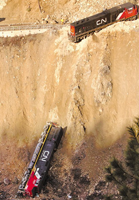
Chief Byron Spinks of the Lytton First Nation knows how the latest CP Rail derailment in the Fraser Canyon could have been prevented.
"We could have controlled the weather," he quips. "That's all we needed to do to prevent it."
Sarcasm aside, a freak storm on July 1st of this year likely caused this latest derailment, which saw a westbound train run head-first into a curtain of hail and rain just north of Lytton.
Pounding rains triggered a rockslide that sent two railcars plunging into the Thompson River.
Despite initial CP reports that the fallen cars had not been punctured, it was confirmed a day later by CP Rail divers inspecting the wreckage that the cargo -- an antifreeze ingredient called ethylene glycol -- was in fact leaking into the river, just in time for an annual Chinook salmon migration.
The little engine that couldn't
Violent storms are just one aspect of the harsh natural conditions that impede rail travel through the Fraser Canyon, a treacherous 80-kilometre stretch of mountains hugging the Fraser River roughly between Yale and the confluence of the Thompson River above Lytton. The steep mountain topography means that both the relatively flat CP and Canadian National (CN) rail beds must be cut into very steep slopes high above the river, creating areas prone to mud and rockslides.
Over the last three years alone, the area around Lytton has emerged as a flashpoint for train accidents in B.C. -- five derailments have occurred within a 25-kilometre radius of the village of Lytton during this time, three of which were serious.
"There's a lot of hazardous goods moving through our territory by rail, and it's just a matter of time until one of those is going to get derailed," says Spinks. "We're trying to emphasize that to CP and CN right now."
Concerned that a toxic spill on the scale of the 2005 Cheakamus River disaster is now inevitable, native leaders are calling for a new and improved vision of railway safety for their traditional territories from Vancouver to the Shuswap.
"I think the railway industry needs a swift kick in the ass," says Grand Chief Doug Kelly, a member of the First Nations Summit executive, which is calling for immediate meetings with both CP and CN in the wake of the Lytton derailment "We need... CN and CP Rail to begin exploring with First Nations what safety measures are needed, and where they most need to happen."
Future accidents -- inevitable?
Both CP and CN have experienced a doubling of rail traffic over the last decade; many trains have gotten longer and heavier, a phenomena that some say has made their rail operations increasingly unsafe.
"When you run more trains, you cause more wear and tear on the track and the equipment," says Bill Brehl, president of Teamster Canada Rail Conference Maintenance Division, which represents 4500 workers who inspect, build and maintain track for CP Rail and others across Canada. "But the more trains you run, the less time you have to go out and inspect the track, because trains are running a lot of the time."
Between 2002 and 2005, the number of railway accidents in Canada -- excluding crossing and trespassing accidents -- increased sharply. In 2007, the Transportation Safety Board reported that CP Rail trains alone suffered 51 main-track derailments across Canada, up from 42 the year before. Nearly one quarter of all main-rack derailments reported to the federal government in 2007 occurred in British Columbia.
The "safest" railroad
CP Rail spokesman Mike LoVecchio defends his company's safety record, particularly when it is compared with the six other class one railways currently operating in North America.
"CP has been the safest railroad in North America for six of the last seven years," he says. "We have emergency plans in place for all contingencies, and we exceed all Transport Canada requirements and regulations for the carriage of goods." (The federal Transportation Safety Board did not return calls from The Tyee.)
In the case of the Fraser Canyon, LoVecchio says his company does everything it can to ensure that its trains run safely, including the use of automated slide detectors which are wired into the steep canyon slopes.
"Slide detectors do not take holidays, and they don't take coffee breaks," he says. "Beyond this, any time we can identify an improved [safety] process, we are going to embrace it."
Safe salmon
Improved safety processes are exactly what Grand Chief Doug Kelly is hoping the rail companies will buy into, given what he describes as "significant reductions" in the number of cabooses and staff engaged in safety monitoring on the ground.
A priority for Kelly is to identify the most ecologically important stretches of salmon-bearing river adjacent to rail-lines between Lytton and Vancouver, and ensure that extra measures are taken to ensure salmon are adequately protected.
"Why can't we increase the surveillance of rail lines in these specially identified areas, including routine [foot] patrols, so we can identify landslides, mudslides, timber and windfall debris on the line well ahead of time?"
He adds that new kinds of railcars need to be developed to safely carry hazardous materials, so that fish aren't completely wiped out by toxic spills, as was the case with a CN Rail spill on the Cheakamus River near Squamish.
(Mike LoVecchio told The Tyee that CP Rail has not received a formal request for meetings from Kelly and the FNS, but that his company is "happy to meet with them at their convenience.")
Volunteer protection
Lytton Mayor Chris O'Connor has a vision of railway safety for the canyon, and it jibes with that of Byron Spinks and at least four other nearby native bands.
"What is lacking in all of this is an adequate emergency response," says O'Connor. "We don't know what's causing [trains] to fall off the track, but we do know that these communities all along the line are protected in their emergency response by people who are only volunteers."
O'Connor says Lytton currently has two fire trucks, a tanker truck, and a volunteer fire department that lacks the advanced skills to deal with serious rail accidents. He cites a January 2007 Thompson River derailment where a train crew had to wait for hours in their locomotive for an adequately-trained rescue team to arrive from Agassiz.
O'Connor and Spinks hope to see a regional training centre established at the new fire hall planned for Lytton, which would see volunteers from all over the region -- including the small First Nations whose territories touch the Canyon rail lines -- trained to deal with emergency first response.
"I think as we go along, more and more aboriginal communities will have the same concerns," says Spinks. "[Accidents] are becoming a risk the companies calculate into their business, but we don't view it that way."
Related Tyee stories:
- Feds Nix Rescue Plan to Scoop, Move Salmon
Researcher Alexandra Morton may try it anyway. - One Wreck after Another
As CN derailments mount, so does fear along the tracks. - Railgate Just Got Stranger
Fast ferries, secret e-mails, mystery hard drives: Basi-Virk case's wild week.
Read more: Health, Transportation, Environment















Tyee Commenting Guidelines
Comments that violate guidelines risk being deleted, and violations may result in a temporary or permanent user ban. Maintain the spirit of good conversation to stay in the discussion.
*Please note The Tyee is not a forum for spreading misinformation about COVID-19, denying its existence or minimizing its risk to public health.
Do:
Do not: